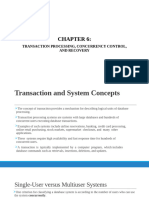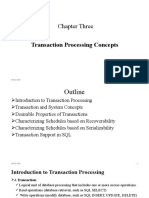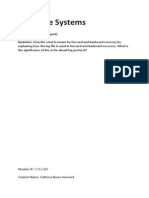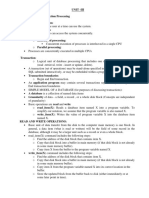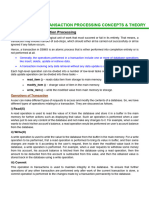Chapter 10 Dbms
Uploaded by
Saloni VaniChapter 10 Dbms
Uploaded by
Saloni VaniIntroduction to Transaction Processing Concepts
and Theory
TRANSACTION : Set of operations to perform certain task or function. Eg. Like-
money transfer includes certain steps which is followed to succssefully
transfer money from one account to another.
“A transaction (set of operations) may be stand-alone specified in a high level
language like SQL submitted interactively, or may be embedded within a program”
.
TRANSACTION PROCESSING SYSTEM:
are systems with large databases and hundreds of concurrent users executing
database transactions. These systems require high availability and fast
response time for hundreds of concurrent users.
We define the concept of a transaction, which is used to represent a logical
unit of database processing that must be completed in its entirety to ensure
correctness.
A transaction is typically implemented by a computer program, which
includes database commands such as retrievals, insertions, deletions, and
updates.
includes two functions: Read(X) Write(X)
ACID PROPERTIES: In order to maintain consistency in database before and after
transactions certain properties are followed:
ATOMICITY: entire transaction take palce or does not happen.
CONSISTENCY: Database must be cconsistent after or before tx.
ISOLATION: Multiple transaction occur independently without interference
DURABILITY(long term, permanent): The changes of successful transaction occur
even the system failure occur.
Transaction boundaries:
Begin and End transaction.
A transaction is an executing program that forms a logical unit of database
processing. A transaction includes one or more database access operations—
these can include insertion, deletion, modification, or retrieval operations.
The database operations that form a transaction can either be
* embedded within an application program or they can be
* specified interactively via a high-level query language such as SQL.
* One way of specifying the transaction boundaries is by specifying explicit
begin transaction and end transaction statements in an application program.
READ-ONLY-TRANSACTION : If the database operations in a
transaction do not update the database but only retrieve data
Otherwise it is known as READ-WRITE TRANSACTION.
An application program may contain several transactions separated by the
Begin and End transaction boundaries.
SLIDE-3
A database is basically represented as a collection of named data items.
Data item =eg. Emp_name
The size of a data item is called its granularity(size of data that is allowed
to be locked).
A data item can be a database record
Can be very large as whole disk or can be very small unit such as individual
field (attribute) value of some record in the database.
independent of the data item granularity (size) and apply to data items in
general. Each data item has a unique name, but this name is not typically used
by the programmer; rather, it is just a means to uniquely identify each data
item.
Executing a read_item(X) command includes the following
steps:
1. Find the address of the disk block that contains item X.
2. Copy that disk block into a buffer in main memory (if that disk block is
not already in some main memory buffer).
3. Copy item X from the buffer to the program variable named X.
(user --> DBMS-->Hard Disk || CPU --> RAM(fast) -->HD(slow)(commit)
Executing a write_item(X) command includes the following steps:
1. Find the address of the disk block that contains item X.
2. Copy that disk block into a buffer in main memory (if that disk block is
not already in some main memory buffer).
3. Copy item X from the program variable named X into its correct location in
the buffer.
4. Store the updated block from the buffer back to disk (either immediately
or at some later point in time).
A process is resumed at the point where it was suspended when
ever it gets its turn to use the CPU again. Hence, concurrent execution of
processes is actually interleaved,
the types of problems we may encounter with these two simple transactions if
they run concurrently
State Transition Diagram : States for Transaction Execution
BEGIN_TRANSACTION. This marks the beginning of transaction execution.
■ READ or WRITE. These specify read or write operations on the database
items that are executed as part of a transaction.
■ END_TRANSACTION. This specifies that READ and WRITE transaction operations
have ended and marks the end of transaction execution. However, at
this point it may be necessary to check whether the changes introduced by752
Chapter 21 Introduction to Transaction Processing Concepts and Theory
Active Begin transaction End transaction Commit Abort Abort Read, Write
Partially committed Failed Terminated Committed
State transition diagram illustrating the states for transaction execution.
the transaction can be permanently applied to the database (committed) or
whether the transaction has to be aborted because it violates serializability
(see Section 21.5) or for some other reason.
■ COMMIT_TRANSACTION. This signals a successful end of the transaction so
that any changes (updates) executed by the transaction can be safely
committed to the database and will not be undone.
■ ROLLBACK (or ABORT). This signals that the transaction has ended unsuc
cessfully, so that any changes or effects that the transaction may have applied
to the database must be undone.
The System Log
1. [start_transaction, T]. Indicates that transaction T has started
execution.
2. [write_item, T, X, old_value, new_value]. Indicates that
transaction T has
changed the value of database item X from old_value to new_value.
3. [read_item, T, X]. Indicates that transaction T has read the value
of database item X.
4. [commit, T]. Indicates that transaction T has completed
successfully, and affirms that its effect can be committed (recorded
permanently) to the data base.
5. [abort, T]. Indicates that transaction T has been aborted.
Protocols for recovery that avoid cascading rollbacks (see Section
21.4.2)—which include nearly all practical protocols—do not
require that READ operations are written to the system log. However,
if the log is also used for other purposes—such as auditing (keeping
track of all database operations)—then such entries can be
included. Additionally, some recovery protocols require simpler
WRITE entries only
include one of new_value and old_value instead of including both (see
Section 21.4.2).t we are assuming that all permanent changes to the
database occur within transactions, so the notion of recovery from
a transaction failure amounts to either undoing or redoing
transaction operations individually from the log. If the system
crashes, we can recover to a consistent database state by examining
the log and using one of the techniques described in Chapter 23.
Because the log contains a record of every WRITE operation that
changes the value of some database item, it is
possible to undo the effect of these WRITE operations of a transaction
T by tracing backward through the log and resetting all items changed
by a WRITE operation of T to their old_values. Redo of an operation
may also be necessary if a transaction has its updates recorded in
the log but a failure occurs before the system can be sure that
all these new_values have been written to the actual database on disk
from the main memory buffers.7
You might also like
- Commvault Complete Data Protection Customer PresentationNo ratings yetCommvault Complete Data Protection Customer Presentation33 pages
- The University of Dodoma College of Informatics and Virtual EducationNo ratings yetThe University of Dodoma College of Informatics and Virtual Education44 pages
- Chapter 3 Transaction Processing ConceptsNo ratings yetChapter 3 Transaction Processing Concepts40 pages
- Module 5 Part1 Introduction To Transaction ProcessingNo ratings yetModule 5 Part1 Introduction To Transaction Processing76 pages
- Transaction Processing Concepts and TheoryNo ratings yetTransaction Processing Concepts and Theory56 pages
- Introduction To Transaction Processing Concepts and TheoryNo ratings yetIntroduction To Transaction Processing Concepts and Theory52 pages
- Transaction Management & Concurrency ControlNo ratings yetTransaction Management & Concurrency Control141 pages
- Chapter 7 - Transaction Processing ConceptsNo ratings yetChapter 7 - Transaction Processing Concepts21 pages
- Cs8492 Database Management Systems 359992518 DbmsNo ratings yetCs8492 Database Management Systems 359992518 Dbms149 pages
- ADB - CH4 - Transaction Management and RecoveryNo ratings yetADB - CH4 - Transaction Management and Recovery80 pages
- Chapter 3 Transaction Processing ConceptesNo ratings yetChapter 3 Transaction Processing Conceptes75 pages
- 4. Transaction Management Concurrency Control and backupNo ratings yet4. Transaction Management Concurrency Control and backup24 pages
- Advanced Database Systems: Chapter 4: Transaction ManagementNo ratings yetAdvanced Database Systems: Chapter 4: Transaction Management78 pages
- Introduction To Transaction Processing Concepts and TheoryNo ratings yetIntroduction To Transaction Processing Concepts and Theory47 pages
- Bajaj Finserv (2nd Visit) Recruitment Drive-Interview On 17th Sept'2022 For 2023 Graduating BatchNo ratings yetBajaj Finserv (2nd Visit) Recruitment Drive-Interview On 17th Sept'2022 For 2023 Graduating Batch4 pages
- Lecture 3 - Framework For Project ManagementNo ratings yetLecture 3 - Framework For Project Management51 pages
- [ebook] Supercharge Your Workday with ChatGPT100% (4)[ebook] Supercharge Your Workday with ChatGPT38 pages
- 89-0022 Blackmagic Hyperd - st2 Hyperdeck Studio2 Disk Recorder - Canfordised DatasheetNo ratings yet89-0022 Blackmagic Hyperd - st2 Hyperdeck Studio2 Disk Recorder - Canfordised Datasheet2 pages
- Aa - Req - 000131 - Quality Requirements Third Party Design VerificationNo ratings yetAa - Req - 000131 - Quality Requirements Third Party Design Verification11 pages
- Escalado / PLC - 1 (CPU 1214C AC/DC/Rly) / Program BlocksNo ratings yetEscalado / PLC - 1 (CPU 1214C AC/DC/Rly) / Program Blocks2 pages
- Commvault Complete Data Protection Customer PresentationCommvault Complete Data Protection Customer Presentation
- The University of Dodoma College of Informatics and Virtual EducationThe University of Dodoma College of Informatics and Virtual Education
- Module 5 Part1 Introduction To Transaction ProcessingModule 5 Part1 Introduction To Transaction Processing
- Introduction To Transaction Processing Concepts and TheoryIntroduction To Transaction Processing Concepts and Theory
- 4. Transaction Management Concurrency Control and backup4. Transaction Management Concurrency Control and backup
- Advanced Database Systems: Chapter 4: Transaction ManagementAdvanced Database Systems: Chapter 4: Transaction Management
- Introduction To Transaction Processing Concepts and TheoryIntroduction To Transaction Processing Concepts and Theory
- Professional SQL Server 2012 Internals and TroubleshootingFrom EverandProfessional SQL Server 2012 Internals and Troubleshooting
- Bajaj Finserv (2nd Visit) Recruitment Drive-Interview On 17th Sept'2022 For 2023 Graduating BatchBajaj Finserv (2nd Visit) Recruitment Drive-Interview On 17th Sept'2022 For 2023 Graduating Batch
- 89-0022 Blackmagic Hyperd - st2 Hyperdeck Studio2 Disk Recorder - Canfordised Datasheet89-0022 Blackmagic Hyperd - st2 Hyperdeck Studio2 Disk Recorder - Canfordised Datasheet
- Aa - Req - 000131 - Quality Requirements Third Party Design VerificationAa - Req - 000131 - Quality Requirements Third Party Design Verification
- Escalado / PLC - 1 (CPU 1214C AC/DC/Rly) / Program BlocksEscalado / PLC - 1 (CPU 1214C AC/DC/Rly) / Program Blocks





